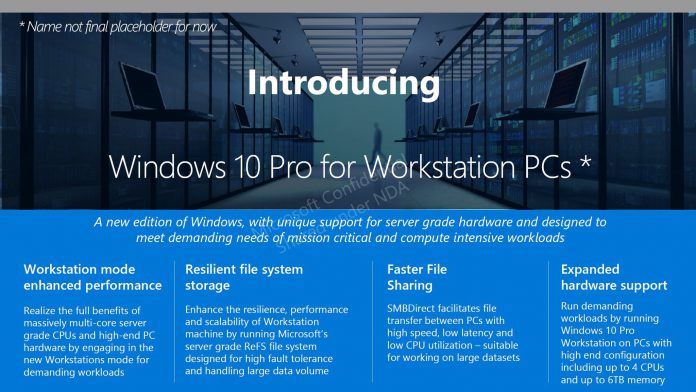One of the new SKUs will be called Windows 10 Pro for Workstations. Some Windows users of a certain vintage may remember that Microsoft used to use the ‘Workstations’ name two decades ago. As the name suggests, Windows 10 Pro for Workstations will be a specific SKU that will be for Advanced PCs. It is worth noting that Microsoft could well change the final name of the version before release. Indeed, the slide image says that the name is a placeholder for the time being. This SKU will be for customers with high-end, server grade computing hardware. Microsoft says the build will be focused on ‘mission critical and computer intensive workloads’. Windows 10 Pro for Workstations will feature a new NTFS file system. The SKU will also have the following features:
Workstation mode: Microsoft plans to optimize the OS by identifying “typical compute and graphics intensive workloads” to provide peak performance and reliability when Workstation mode is enabled. Resilient file system: Microsoft’s file system successor to NTFS, dubbed ReFS, is enabled in this new version, with support for fault-tolerance, optimized for large data volumes, and auto-correcting. Faster file handling: As workstation machines are typically used for large data volumes across networks, Microsoft is including the SMBDirect protocol for file sharing and high throughput, low latency, and low CPU utilization when accessing network shares. Expanded hardware support: Microsoft is also planning to allow Windows 10 Pro for Workstation on machines with up to 4 CPUs and a memory limit of 6TB. Windows 10 Pro currently only supports 2 CPUs.
Expanding the Windows 10 Ecosystem
Through the chaos of Microsoft’s accidental leak, some eagle-eyed watchers found three new Windows 10 SKUs. Specifically, Windows 10 Pro for Advanced PCs, Windows 10 Pro N for Advanced PCs, and Windows Server 2016 ServerRdsh. We have also recently reported on Microsoft’s efforts to create a new Windows 10 Mobile variant. A report last month suggested the company is building a new version that would allow the introduction of new devices.




